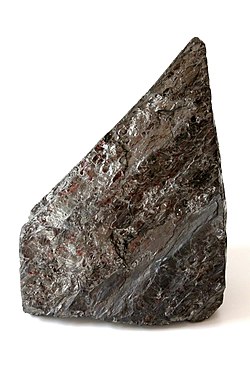| Metamorphic rock | |
 Anthracite coal | |
| Composition | |
|---|---|
| 86–97% carbon[1] |
Anthracite, also known as hard coal and black coal, is a hard, compact variety of coal that has a submetallic lustre. It has the highest carbon content, the fewest impurities, and the highest energy density of all types of coal and is the highest ranking of coals.
The Coal Region of Northeastern Pennsylvania in the United States has the largest known deposits of anthracite coal in the world with an estimated reserve of seven billion short tons.[2] China accounts for the majority of global production; other producers include Russia, Ukraine, North Korea, South Africa, Vietnam, Australia, Canada, and the United States. Total production in 2020 was 615 million tons.[3]
Anthracite is the most metamorphosed type of coal, but still represents low-grade metamorphism,[a] in which the carbon content is between 86% and 97%.[1][5][6] The term is applied to those varieties of coal which do not give off tarry or other hydrocarbon vapours when heated below their point of ignition.[7] Anthracite is difficult to ignite, and burns with a short, blue, and smokeless flame.
Anthracite is categorized into several grades. Standard grade is used predominantly in power generation, and high grade (HG) and ultra high grade (UHG), are used predominantly in the metallurgy sector. Anthracite accounts for about 1% of global coal reserves,[8] and is mined in only a few countries around the world.
- ^ a b "Coal explained". U.S. Energy Information Administration. Archived from the original on 2019-08-29. Retrieved 16 January 2022.
- ^ Carpenito, Thomas (2019) "The State of Coal and Renewable Energy in Schuylkill County", https://medium.com/@thomascarpenito3/state-of-coal-and-renewable-energy-in-schuylkill-f8850fec3fa6
- ^ "International Energy Statistics". Energy Information Administration.
- ^ Quinn, A.W.; Glass, H.D. (1958). "Rank of Coal and Metamorphic Grade of Rocks of the Narragansett Basin of Rhode Island". Economic Geology. 53 (5): 563–576. Bibcode:1958EcGeo..53..563Q. doi:10.2113/gsecongeo.53.5.563.
- ^ "MIN 454: Underground Mining Methods handout; from course at the University of Alaska Fairbanks". Archived from the original on 26 March 2009. Retrieved 2009-05-05.
- ^ Stefanenko, R. (1983). Coal Mining Technology: Theory and Practice. Society for Mining Metallurgy. ISBN 0-89520-404-5.
- ^ Bauerman 1911, p. 105.
- ^ "The Coal Resource: A Comprehensive Overview of Coal" (PDF). World Coal Institute. Archived from the original (PDF) on 15 October 2009.
Cite error: There are <ref group=lower-alpha> tags or {{efn}} templates on this page, but the references will not show without a {{reflist|group=lower-alpha}} template or {{notelist}} template (see the help page).